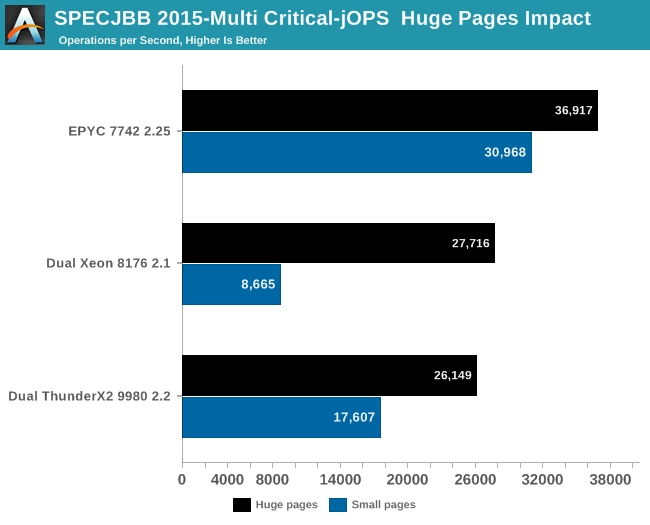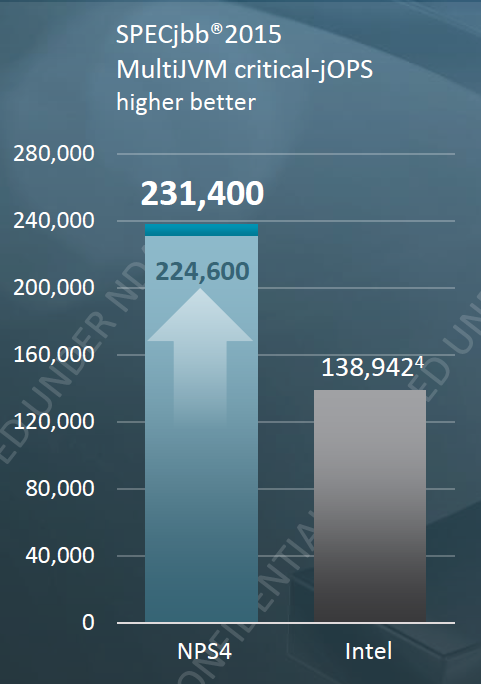AMD Rome Second Generation EPYC Review: 2x 64-core Benchmarked
by Johan De Gelas on August 7, 2019 7:00 PM ESTJava Performance
Even though our testing is not the ideal case for AMD (you would probably choose 8 or even 16 back-ends), the EPYC edges out the Xeon 8176. Using 8 JVMs increases the gap from 1% to 4-5%.
The Critical-jOPS metric is a throughput metric under response time constraint.

With this number of threads active, you can get much higher Critical-jOps by significantly increasing the RAM per JVM. However, we did not want that as this would mean we can not compare with systems that can only accommodate 128 GB of RAM. Notice how badly the Intel system needs huge pages.
The benchmark data of Intel and AMD can be found below.
According to AMD, the EPYC 7742 can be up to 66% faster. However note that these kind of high scores for critical-jOPS are sometimes configured with 1 TB of RAM and more.











180 Comments
View All Comments
Zoolook - Saturday, August 10, 2019 - link
It's been a pretty good investment for me, bought at 8$ two years ago, seems like I'll keep it for a while longer.CheapSushi - Wednesday, August 7, 2019 - link
It's glorious...one might say.... even EPYC.abufrejoval - Wednesday, August 7, 2019 - link
Hard to believe a 64 core CPU can be had for the price of a used middle class car or the price of four GTX 2080ti.Of course once you add 2TB of RAM and as many PCIe 4 SSDs as those lanes will feed, it no longer feels that affordable.
There is a lot of clouds still running ancient Sandy/Ivy Bridge and Haswell CPUs: I guess replacing those will eat quite a lot of chips.
And to think that it's the very same 8-core part that powers the engire range: That stroke of simplicity and genius took so many years of planning ahead and staying on track during times when AMD was really not doing well. Almost makes you believe that corporations owned by share holders can actually sometimes actually execute a strategy, without Facebook type voting rights.
Raising my coffee mug in a salute!
schujj07 - Thursday, August 8, 2019 - link
Sandy Bridge maxed out at 8c/16t.Ivy Bridge maxed out at 15c/30t.
Haswell maxed out at 18c/36t.
That means that a single socket Epyc 64c/128t can give you more CPU cores than a quad socket Sandy Bridge (32c/64t) or Ivy Bridge (60c/120t) and only a few less cores that a quad socket Haswell (72c/144t).
Eris_Floralia - Wednesday, August 7, 2019 - link
This is what we've all been waiting for!Eris_Floralia - Wednesday, August 7, 2019 - link
Thank you for all the work!quorm - Wednesday, August 7, 2019 - link
Given the range of configurations and prices here, I don't see much room for threadripper. Maybe 16 - 32 cores with higher clock speeds? Really wondering what a new threadripper can bring to the table.willis936 - Wednesday, August 7, 2019 - link
A reduced feature set and lower prices, namely.quorm - Wednesday, August 7, 2019 - link
Reduced in what way, though? I'm assuming threadripper will be 4 chiplets, 64 pcie lanes, single socket only. All ryzen support ecc.So, what can it offer? At 32 cores, 8 channel memory becomes useful for a lot of workloads. Seems like a lot of professionals would just choose epyc this time. On the other end, I don't think any gamers need more than a 3900x/3950x. Is threadripper just going to be for bragging rights?
quorm - Wednesday, August 7, 2019 - link
Sorry, forgot to add, 3950x is $750, epyc 7302p is $825. Where is threadripper going to fit?